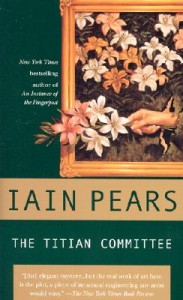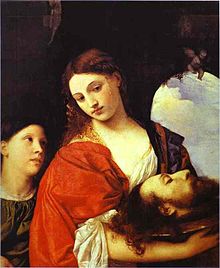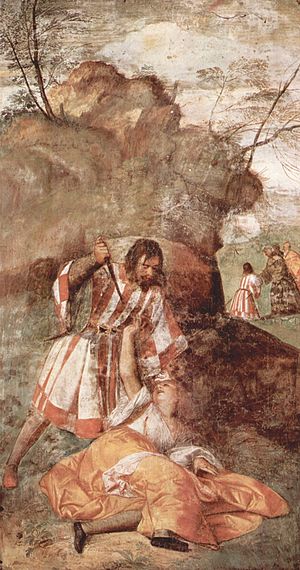
Mysteries I love tend to have one thing in common- great characters. Flavia di Stefano of Rome’s Art Theft Squad and Jonathon Argyll, art dealer/historian fit the bill. I have a fondness for couples in mysteries, and even though these two are not actually together yet, you know they will be. She’s beautiful, smart, decisive, blunt. He’s bumbling and endearing. While she sticks with the case, he tends to get lost in the art. I like how they interact with each other, how their differences fit together so well.
The Titian Committee is actually a reread for me. I read all of Pears’ Art History Mysteries years ago, but when I decided to join the Venice in February challenge, I though it would be a great excuse to revisit the series. I didn’t remember the plot at all. I just remembered that I enjoyed it, and I did this time too.

In The Titian Committee, Flavia is sent to Venice to investigate the murder of an American art historian, Louise Masterson, a member of the scholarly international Titian Committee. She is found stabbed to death in a bed of lilies at the Giardinetti Reali. But the bodies start adding up. Tony Roberts, another member of the committee, drowns in a canal, and art philosopher Georges Bralle is discovered suffocated in his home in France. Flavia questions the suspects, each of whom has their own reasons for wanting the victims dead, while Jonathon studies Titian’s paintings, hoping to find whatever revelation Masterson was working on before her death.
I’m not an art history buff; you don’t have to be to enjoy this mystery. Pears tells you everything you need to know, not in a pedantic way. He makes it interesting, he pulls me into the art world, into the jealousies and rivalries, the ins and outs of dealing in paintings, even the drama in the long-dead painters’ lives.
The book ends with a traditional denouement. All the suspects are gathered in one room as Flavia’s boss explains the sequence of events, or at least the version of events he and Flavia have decided should be the official version. I like that Flavia and her boss are willing to overlook certain details, that justice is not always black and white.

Titian was, by the way, the master painter in Venice during the 16th century. In the course of a very long and highly prolific career he dominated Venice’s art during its golden age and also worked for many illustrious patrons outside the city. He was one of the most versatile Italian painters, equally adept with portraits, landscape backgrounds, and mythological and religious subjects. The Titian Committee mostly centers on a set of panels Titian painted depicting St. Anthony. His painting methods, particularly in the application and use of color, would exercise a profound influence not only on painters of the Italian Renaissance, but on future generations of Western artists. Don’t you love it when fiction teaches you something or inspires you to do a little research on a topic?
3 ½ out of 5 stars
Venice in February is hosted by Snow Feathers and Dolce Bellezza.
Category: Mystery
Art History Mystery #2
First published 1991
189 pages
Book source: Library
Art History Mysteries
- The Raphael Affair
- The Titian Committee
- The Bernini Bust
- The Last Judgement
- Giotto’s Hand
- Death and Restoration
- The Immaculate Deception
Art, mystery, Venice – makes me very excited to see these three together. Plus the fact that you learn a lot about the topics and Italy. Great review.
Yes I love when a book inspires me to read more or that I learn more :=D
This is why I love historical fiction so much. It always inspires me to do research on the people and places in the story. I do love anything set in Venice, this sounds good 🙂
The last book of Pears I read was The Dream of Sciopio, which I loathed, and An Instance at The Fingerpost which I can’t remember. But, a painter in Venice sounds much more interesting! Especially since he is an art historian.
I loved An Instance of the Fingerpost, but these are an entirely different style- easier, lighter, funner I guess.
I’ve not read any of Iain Pears’ mysteries because I was so intimidated by (and eventually bored by, I admit, though I think that is my own fault) The Instance of the Fingerpost. It sounded SO great to me and I was SO excited to read it and then… I just didn’t love it. So I have avoided Pears since then, very immaturely!
Like I said above, the Art History Mysteries have a totally different feeling than An Instance of the Fingerpost. At first, I was actually surprised they were written by the same author.
I don’t think I’ve read this genre, but I think I would like it. I love art history. I almost majored in it. Reading all of these reviews from Venice are making me want to go!
I would love to visit Venice. Unfortunately I think reading about it is the closest I’m going to get in the near future.
Iain Pears has been on my list to read for ages, but I have yet to read anything by him. I hadn’t even heard of this one by him before now.